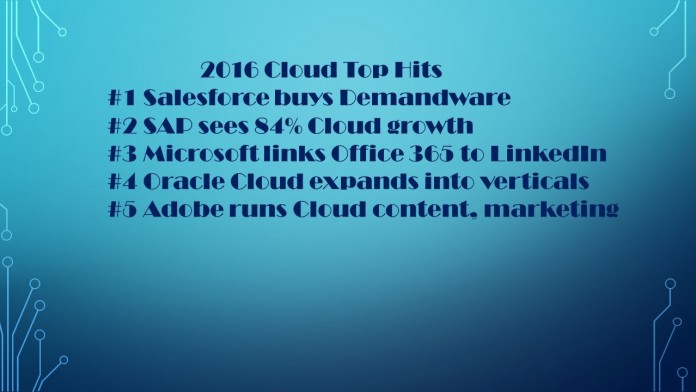In 2015, the worldwide Cloud applications market reached $47.3 billion in Cloud subscription revenues, a 20% jump from 2014, while the top 25 vendors accounted for nearly 51% of the market as their Cloud revenues jumped 30%.
Vendors such as Salesforce, SAP, Oracle, and FIS Global expanded aggressively with a series of acquisitions in 2015 buoying their Cloud applications revenues along the way. The rest of the market – including other entities from our roster of Cloud Top 500 as well as a far greater number of smaller firms in our database of 3,000+ vendors – went along for the ride by registering a 11% rise even though collectively they only accounted for 49% of the total last year, compared with 53% in 2014.
The growing concentration of Cloud applications revenues in the hands of leading players such as the Top Five (Salesforce, SAP, Microsoft, Oracle and Adobe) – representing 28% of the market in 2015, compared with 26% in 2014 – highlighted the fact that their race to become the No. 1 has never been more intense. What all of them have in common is their desire to get to the next major milestone by becoming the first with $10 billion in cloud applications revenues.
Their urgency came into full frontal display in June 2016 when Salesforce announced its biggest acquisition to date with its $2.8-billion purchase of Demandware, a steep price given that the eCommerce apps vendor only has 331 customers.
Microsoft Buys LinkedIn, Morphing Into A Cloud Champion
Less than two weeks later, Microsoft unveiled its largest acquisition by forking over a staggering $26.2 billion for LinkedIn, opening a new chapter in its 41-year run as the king of PC computing. By owning LinkedIn and the ability to reach its 433 million members, Microsoft is angling to dominate the Cloud applications market especially in such key areas as CRM, HCM, eLearning as well as Collaboration.
Instead of being seen as the relics of the PC era, the new Microsoft management team led by Satya Nadella, who took over the CEO post from Steve Ballmer in 2014, is reinventing the company by striking the rich deal. Buying LinkedIn and putting its current CEO Jeff Weiner in charge of the San Francisco subsidiary represents not just Microsoft’s future, but also a huge gamble by giving outsiders like Weiner a rare opportunity to help remake Office 365.
After helping people unleash their creative power with the use of knowledge-sharing assets in the forms of an avalanche of Excel, Word and PowerPoint documents, the LinkedIn deal could be interpreted as the equivalent of restructuring the unstructured Cloud with structured data. If anyone can share a kid’s pictures on Instagram effortlessly, wouldn’t it be more powerful when Office 365 users can move beyond their Office confines by sharing their knowledge base on LinkedIn freely and instantaneously?
In other words, LinkedIn could become the key to unlock one’s hard drive and distribute all its contents to anyone looking for ideas. If the manuscripts of someone like Ernest Hemingway could fetch millions of dollars, what would be the collective worth of gazillions of Word files now stored on everyone’s hard drive? In the new era of global collaboration and unbundling of work(more on this in our upcoming Cloud HCM market report), the iterative process of enhancing a product or services could be drastically improved if the Microsoft and LinkedIn combination were to flourish.
Microsoft’s ambitions in the Cloud and the massive numbers needed to succeed are laid bare – 1.2 billion Office users and 433 million LinkedIn members, or nearly 1.7 billion accounts that could be generating healthy recurring revenues for Microsoft for years to come. By comparison, Facebook has more than 1.6 billion active users, while Apple has shipped just a little above 1 billion iPhones as of June 2016. Salesforce, the number 1 Cloud apps vendor, has secured more than 150,000 customers and an estimated 15 to 20 million users.
In one fell swoop, Microsoft has accomplished a task that could have taken the Windows developer years if not decades to build, an immediate beachhead in the Cloud apps market and a potentially mind-blowing experiment in the evolution of the digital economy based on knowledge, content and a fair amount of human ingenuity to combine the two.
The Money Shot
If the past 10 years of Cloud applications market development were considered the foreplay, 2016 could go down as the money shot. This is what a fledgling market is supposed to be doing – going mainstream in a compressed time frame, or in Hollywood’s parlance a blockbuster in the making right before one’s eyes.
Based on written responses from hundreds of vendors and our continuous research on tens of thousands of end-user customers, the Cloud applications market is expected to become the primary reason that sustains the growth of the $200-billion+ enterprise applications space through the five-year forecast period. You can read more on our Cloud applications market forecast here.
Among the Top 25 cloud applications vendors, it’s no longer possible for them to hone in on a single market. In order for them to sustain their torrid growth rates, they are muscling into multiple markets. In its fiscal fourth quarter of 2016, Oracle paid nearly $1.2 billion to acquire Textura in construction and oPower in utility, both of which derive 100% of their revenues from Cloud delivery of industry-specific applications.
Having scored the first-mover advantage as the standard bearer for integrated Cloud HCM because of its world-class usability and design, Workday is moving swiftly into financial management, enterprise performance management as well as adjacent markets from eLearning to machine learning.
ServiceNow is already positioning itself squarely in the vortex of ITSM and enterprise service management. Other vendors are doing the same. In February 2016, Dude Solutions, a Cloud ERP vendor, unveiled TechnologyEssentials, a cloud-based IT asset and workflow management suite for IT professionals. The product complements its ERP apps for education and public sector customers. Additionally, SysAid has added Qlik as a Business Intelligence bool to help boost analytics capabilities of its IT service management offerings.
What it boils down to is the fact that the Cloud applications market is entering a new phase where best-of-breed products from a single vendor represent just the base line. In order to succeed in the long run, Cloud vendors must have a full portfolio of software releases and microservices to offer even though Cloud service delivery from its early reincarnation has been all about addressing discrete functions like file storage, sales force automation, or even Gmail.
That is consistent with the history of the enterprise applications market when it evolves from distinctive products like Lotus 1-2-3 to Office Suites and from modular pillars like Project Management and Supply Chain Management to full-blown ERP suites with integrated capabilities designed for use within an enterprise or multiple industries.
The Cloud, given its flexibility, scalability and continuous release updates, could go one step further with the advent of mobility support, Internet of Things as well as API integration.
Mainstreaming Of The Cloud
That’s why the mainstreaming of the Cloud into the general enterprise applications market has come so quickly and pervasively. Twelve of the Top 25 Cloud applications vendors in our survey have already seen at least half of their revenues coming from Cloud sales. Of this year’s Cloud Top 500 vendors, 323 software companies, or nearly two-thirds of the total, depend on the Cloud for at least half of their product revenues.
Vendors that used to embrace on-premise implementations such as Infosys, an Indian system integration that has made its name by bagging multi-year ERP deals worth hundreds of millions of dollars in services revenues are now changing their tack. Its software division Infosys Finacle, now known as EdgeVerve, is touting Cloud First banking in front of its bank clients, in addition to a connected ecosystem of financial and non-financial entities to take advantage of open banking services for the general population at large.
Perhaps the lesson to be learned from the sharp turns that the Cloud applications market has taken since we last updated the Cloud Top 500 report in September 2015 is that these changes do not happen overnight, but they have a tendency of lurking in close proximity and waiting for a chance to hit squarely in the face.
For more than a decade, the real-estate apps market – primarily for functions like rental property management – has been largely led by a handful of vendors like RealPage and Yardi that have succeeded in migrating to the Cloud in a relatively short amount of time. In 2015, Buildium became one of the fastest growing Cloud apps vendors focusing on the same market where RealPage and Yardi have come to dominate.
One key reason behind Buildium’s robust growth has been its simple pricing, which ranges from $45 per unit per month for a single property to as little as 40 cents per unit per month for owners with thousands of units. Even though it remains a fraction of the size of RealPage or Yardi, Buildium reported 90 percent growth in 2015 and is now serving more than 12,500 customers in 46 countries, totaling nearly one million residential units under management. Last year it also acquired All Property Management, an online marketing service for property managers.
Vendors like Buildium may not be able to overtake its larger rivals in short order and it could take years before Microsoft knocks Salesforce off its perch in the Cloud applications market. But when they do, the change would not be one bit surprising given the pace of change in the Cloud applications market where the least expected could happen right before our eyes.
The following table highlights major developments that the top 25 Cloud applications vendors are undertaking in order to sustain their growth, along with their 2014-2015 Cloud subscription revenues and their customer count.
Top 25 Cloud Applications Vendors In Target Markets With 2014-2015 Revenues, 2014-2015 Growth, 2015 Cloud Applications Market Shares, and Recent Developments
| Rank | Vendor | Key Cloud Markets | 2015 Cloud Apps Revenues, $M | 2014 Cloud Apps Revenues, $M | 2014-2015 Change, % | 2015 Cloud Applications Market Share, % | Recent Developments |
|---|---|---|---|---|---|---|---|
| 1 | Salesforce | CRM | 5171 | 4269 | 21% | 11% | In May 2016, Salesforce acquired Demandware for $2.8 billion, the biggest purchase in its history, bolstering its eCommerce and retail applications offerings. |
| 2 | SAP | HCM, ERP | 2568 | 1395 | 84% | 5% | Cloud apps sales soared 50% in 2Q16 with growing HCM customers, rising transactions at Business Network for procurement, travel expense & contingent labor management. |
| 3 | Microsoft | Content Management | 2455 | 2046 | 20% | 5% | In June 2016, Microsoft announced plans to buy LinkedIn for $26.2 billion, its largest acquisition in history, as it aims to strengthen its position in the Cloud applications market. |
| 4 | Oracle | HCM, ERP | 1837 | 1244 | 48% | 4% | Cloud apps and PaaS revenues jumped 49% in its fiscal 2016 with incremental gains from 2016 purchases of Opower and Textura for Cloud-based utility and construction apps. |
| 5 | Adobe Systems | Content Management | 1417 | 1171 | 21% | 3% | Soaring data and mobile transactions buoyed Marketing Cloud, while helping customers achieve digital transformation through accelerating conversion to Cloud content management. |
| 6 | FIS Global | Banking apps | 1336 | 1040 | 28% | 3% | Acquired SunGard Data Systems in late 2015 for its complementary range of products and services in Capital Markets, Wealth and Asset Management, and Risk Management to financial institutions and businesses worldwide |
| 7 | Workday | HCM, ERP | 929 | 613 | 52% | 2% | Reported 100+ live customers for Workday Financials in 2016. Total customer count exceeded 1,300 with growing ambitions in EPM, eLearning and adjacent Cloud markets. |
| 8 | ServiceNow, Inc. | ITSM | 848 | 374 | 127% | 2% | Topping $1 billion in sales in 2015, ServiceNow has signed 230 customers with each paying $1M+ in annualized contract value. |
| 9 | athenahealth | Healthcare apps | 723 | 711 | 2% | 2% | Total revenues rose 20% in first half of 2016 with record numbers of physicians and providers running its apps and network-enabled services for digital healthcare delivery. |
| 10 | IBM | HCM, CRM | 661 | 500 | 32% | 1% | Recent acquisitions of Truven, Merge and others for healthcare analytics is expected to reignite sales of its Cognitive Solutions, which cover the bulk of its software and Cloud applications offerings in 2016. |
| 11 | NetSuite | ERP | 593 | 448 | 32% | 1% | Acquired ERP manufacturing partner IQity’s Cloud business in 2016. |
| 12 | Ultimate Software | HCM | 511 | 419 | 22% | 1% | Established strategic partnership with NetSuite that includes sales referrals. Most recent customer count topped 3,200, up from 2,800 in 2015. Projects up to 25% growth in 2016 sales, compared with 22% in 2015. |
| 13 | LinkedIn Corporation | HCM | 504 | 374 | 35% | 1% | Professional network magnet attracts 433 million members, plenty of eyeballs, religious following among recruiters and staffing firms. In June 2016, it agreed to be acquired by Microsoft for $26.2 billion. |
| 14 | Collaboration | 495 | 412 | 20% | 1% | Named Diane Greene, founder of VMware, in 2015 to lead its Cloud platform and infrastructure business. | |
| 15 | RealPage | Real Estate apps | 454 | 390 | 16% | 1% | Acquired NWP Services for billing in 2016 and Indatus for smart answer automation in 2015. |
| 16 | ACI Worldwide, Inc. | Banking, payments solutions | 446 | 419 | 6% | 1% | Continues to expand its online banking, Cloud payments operations, along with additional eCommerce offerings via recent purchase of PAY.ON. Projects 4-7% organic growth in 2016. |
| 17 | Intuit Inc. | Financials | 404 | 344 | 17% | 1% | Expects QuickBooks online subscribers to reach up to 1.5 million in fiscal 2016 after adding 140,000 in its third quarter. In fiscal 2015, Intuit secured 1.1 million QuickBooks online subscribers. |
| 18 | Cisco Systems | Collaboration | 399 | 270 | 48% | 1% | Acquired Jasper for Cloud-based Internet of Things (IoT) service platform in 2016. |
| 19 | Citrix | Collaboration | 366 | 327 | 12% | 1% | Under a new management team, Citrix plans restructuring by spinning off GoTo collaboration apps in late 2016. |
| 20 | Digital Insight, an NCR company | Banking apps | 356 | 331 | 8% | 1% | Acquired CimpleBox for SaaS-based back-office software to restaurant operators and retailers in 2016. |
| 21 | Constant Contact | CRM | 330 | 325 | 2% | 1% | Acquired by Endurance, a hosting company, for $1.1 billion in 2015. |
| 22 | Veeva Systems Inc. | CRM for life sciences | 316 | 219 | 44% | 1% | Acquired Zinc Ahead for commercial content management apps to support its CRM Cloud for life sciences companies. |
| 23 | Box Inc. | Collaboration | 288 | 203 | 42% | 1% | Enhanced healthcare offerings for streamlining referral management, viewing and sharing medical image files, and marketing FDA-approved Box DICOM Viewer. |
| 24 | ADP | HCM | 287 | 239 | 20% | 1% | Reported 500,000 customers for HCM and Payroll in the Cloud in FY15 and ADP expects most if not all of its 75,000 midmarket customers to migrate to its Cloud-based Workforce Now for Core HR, payroll and talent management by end of fiscal 2017. |
| 25 | Medidata Solutions | Healthcare apps | 286 | 280 | 2% | 1% | Projects up to 21% growth in 2016 sales, compared with 17% in 2015. |
| Subtotal | 23980 | 18363 | 30% | 51% | |||
| Other | 23350 | 21192 | 11% | 49% | |||
| Total | 47330 | 39555 | 20% | 100% |
Further Readings
Our latest market-sizing reports profile the top 10 vendors in each of the 37 markets (see Taxonomy here), offering in-depth analysis of the market dynamics, vendors’ Strengths, Customers, Opportunities, Risks and Ecosystems as well as their ability to gain Shares (SCORES) within their respective space. We also track their successes in the Cloud by breaking down their latest on-premise and Cloud applications revenues. Another metric that we use is win-loss analysis of the quarterly wins of these top vendors and whether incumbents and Cloud upstarts pose any real threat to their standing amid shifting market requirements and user preferences.






